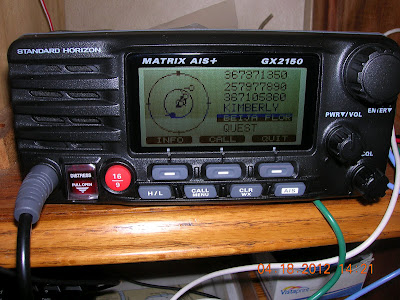The Standard Horizon Matrix GX 2150 + with AIS (Automatic Identification System) was fun to work with.
We got the AIS up and running by simply connecting three wires from the VHF radio to the NMEA 0183 network cable. This is the same cable that powers the Garmin 740 Chart Plotter.
Just connect the
Green, Blue and Gray wires and off it goes. You get a globe at the top right of the screen saying your chart plotter GPS is on and working.
Of course these wires will need to run through the cut out
for flush mounting and will need to be disconnected to do that with the other
power wire and hailer wire.
We had to run over to
West Marine and pick up a flush mount kit. Now really this should be included
in with the radio. Sail boaters get no respect. Still we need to mount it but it was too much fun playing with it.
The AIS is fun, how
practical is yet to be determined 😁
You press the AIS
button and the screen shows the ships in O’s and your vessel in the center as a
triangle. The ships have a line attached to the O to show their direction. It
will list up to ten ships.
We are in San Diego
harbor so at .5 nautical mile radius we still showed about four ships. At 1.0
mil radius there were about 8 ships and made the screen a bit crowded.
You turn
the knob and it cycles through each ship and makes that ships O a solid O
indicating which one it is.
You can press the call button to simply call them.
If you press info then you get all the dirt on the ship, its heeding and Lat
and Long etc.
Among the many
features of the AIS on the VHF is that you can set a distance alarm. So if a
ship is say at 10 nautical miles from you the alarm goes off.
So how would we use it? Well if we were in Mexico and were
sailing or motoring at knight, reading with the autopilot on and the AIS alarm
goes off. You could get up off your you know what and turn on or look at the
radar and see what’s up. Change course or whatever. Besides if you were looking
for fresh bananas then you could keep a look out for the Dole ship😊. The ships names
appear on the AIS screen also. Very cool.
Now the fog horn is another cool feature.
There are about ten different ones to select. At fist when I heard this I though there were ten different sounds but no way there are ten different fog horns for different circumstances. We selected for this test the you are being towed in the fog , fog horn. OK we hopefully will never be getting towed in the fog. We used this because it is a 5 Sec and three 1 sec blasts every 120 sec. Good for testing the haler at the mast which is what is making the noise. The regular fog horn is one blast every 120 sec.
Another feature is you can listen to sports radio while you are fog horning! Yep I got all the the talk on the latest San Diego Charger footballl trades etc :). Guess we will need to figure this one out? Our VHF antenna is not connected yet so the only Chanel we got anything from was 16. Debbie will add the last coax cable end soon and we will get channels. No hurry we still need to mount the radio and finish a suitable spot for the mic.
Debbie set the time and was getting in on the action.
Debbie will be doing any calling as she can speak the Spanish. Like "hay ship what's up, you heading our way!", OK she would not say that but knowing Spanish will help a lot. I can do some spanglish and will be learning it as we go.
The haler is cool also. Plus on the haler and the fog horn you can set the volum.
So I could call Debbie while she is on the for deck by the haler and probably scare the hell out of her :). Now you could use this to talk to another boater that you may be coming along side to at sea, asking to go talk on the VHF or if their radio is not working you could issue orders, he he.







No comments:
Post a Comment